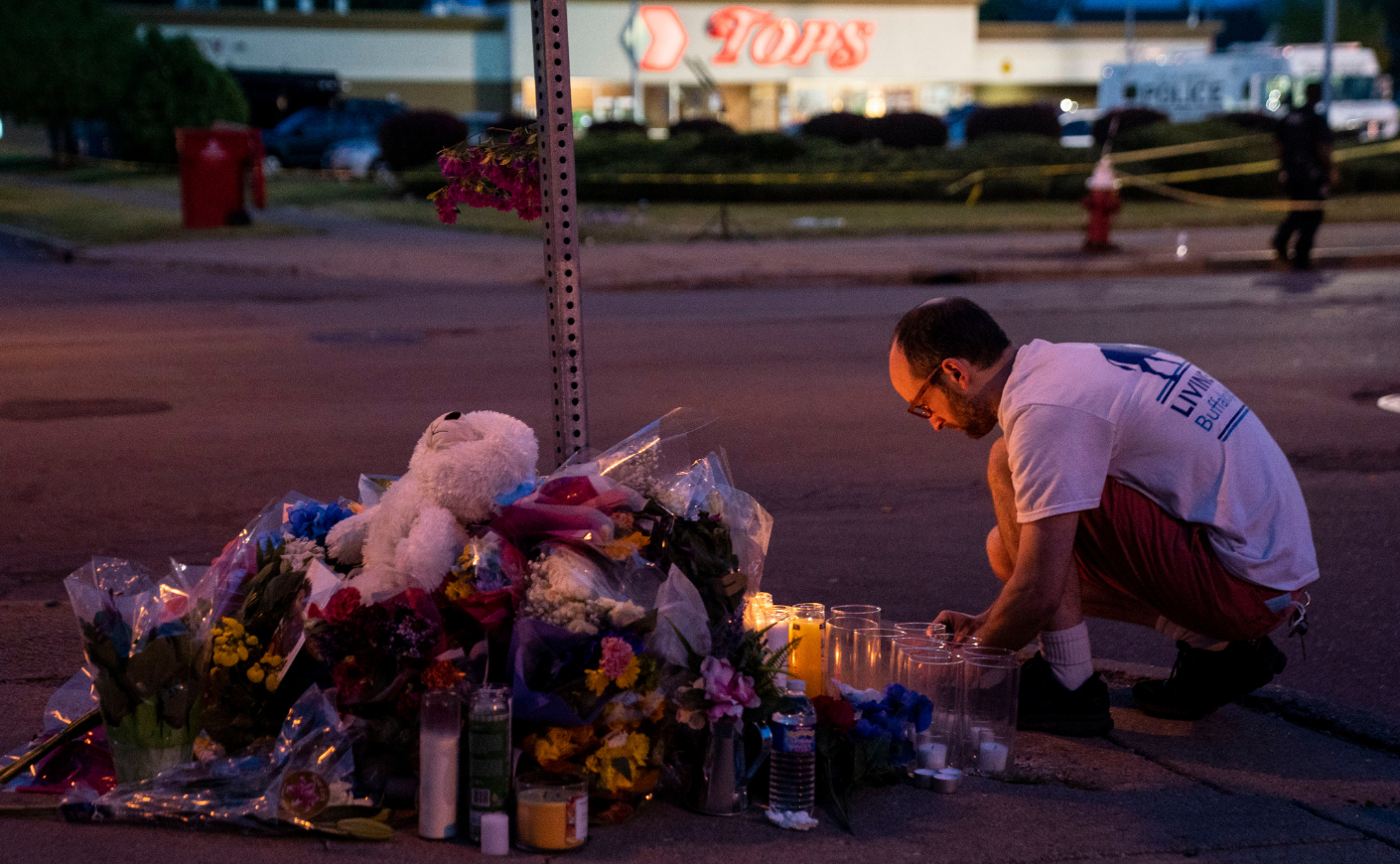Motivated by racial hatred, a white gunman opened fire in a Buffalo supermarket, killing 10 people and injuring three more — almost all of them Black. Here’s what we know so far about the shooting, the victims, and the hate-filled document the shooter left behind.
What happened?
On Saturday afternoon, Payton Gendron, 18, gunned down four people in the parking lot of a Tops Friendly Market, authorities said. He wore a bulletproof vest and a helmet onto which he secured a camera, capturing the carnage and briefly streaming it to viewers on the online platform Twitch. According to police, the gunman then entered the store where he was met by a security guard, Aaron Salter Jr., who shot the man but didn’t penetrate Gendron’s armor.
Gendron shot and killed Salter before turning his assault weapon — which had an anti-Black slur written on it — onto multiple shoppers. When he was confronted by police, Gendron put his gun to his neck, but later surrendered.
“This was pure evil,” Erie County Sheriff John Garcia said at a news conference. “Straight up racially motivated, hate crime from somebody outside of our community.”
President Biden, who will travel to Buffalo this week, addressed the attack on Sunday. "We must all work together to address the hate that remains a stain on the soul of America," he said. "Our hearts are heavy once again, but the resolve must never, ever waver."
Who are the victims of the Buffalo shooting?
A total of 10 victims have been identified from the tragic shooting, ranging from 32 to 86 years old. Here's how each are being remembered:
Katherine “Kat” Massey, 72, was an outspoken advocate for gun control, even writing a letter to the Buffalo News in support of more federal regulations on firearms.
Pearl Young, 77, spent her life helping others and ran a local food bank for more than two decades. "All Pearl knew was church. She was very devoted to her church and a good mother and wife,” her niece, Carolyn Banks, told Buffalo affiliate ABC-7.
Aaron Salter Jr., 55, began what he thought was just going to be another day on the job as a security guard at the Buffalo supermarket when the shooting broke out. He's now being hailed for his bravery after using his police officer training to confront the gunman and saving lives while sacrificing his own.
Ruth Whitfield, 86, was remembered as a "mother to the motherless." Not only was she a proud grandmother of eight grandchildren, she also lived in Buffalo for more than five decades.
Roberta Drury, 32, was remembered by her sister as a "vibrant" and giving soul who had moved to the Buffalo area to take care of her older brother with leukemia.
Heyward Patterson, 67, was known for giving back to his community by offering others rides to the grocery store. At the time of his fatal shooting, he was helping someone load groceries.
Celestine Chaney, 65, was on a mission to get shrimp and strawberry shortcake when the gunman opened fire. But due to her struggles with mobility, she wasn't able to make it to safety with her sister in time.
Geraldine Chapman Talley, 62, was an expert baker and known for her warmth. Her niece heard the police sirens outside the supermarket before she learned the tragic news of her aunt's death.
Andre Mackneil, 53, was picking up a birthday cake for his three-year-old son when he was gunned down. "He was so genuine and so sweet and so kind — like no kind of person I’ve ever met before,” his fiancé Tracey Maciulewicz told The New York Times.
Margus Morrison, 52, was described a "hero" to the family by his stepdaughter, Sandra Demps. On the day of his death, he was out buying snacks for a movie date with his wife.
What’s known about the suspected gunman?
Gendron traveled about 200 miles from his home in Conklin, New York to commit the attack, according to police. Investigators believe he researched the demographics of the area and targeted the neighborhood because it’s predominantly Black.
Last year, Gendron had threatened to commit a shooting at his high school and was taken to a hospital by police where he received a mental health evaluation. He wasn’t charged with a crime and was released within a day and a half, the AP reports.
What’s known about Gendron’s racist motives?
Gendron posted a 180-page document online that outlined his plans for the attack and reasons for carrying it out, per the AP. Throughout the screed, the shooter referenced the racist concept of “replacement theory.” The doctrine, which contends that white people are at risk of being replaced by people of color, was popularized by the French author Renaud Camus in the early 2010s.
These conspiracy theories about the threat of a white genocide were initially popular among the far-right fringe, but in recent years have been taken up by some politicians and even mainstream pundits. They’ve also motivated a string of mass shootings, the New York Times reports. Gunmen have referred to replacement theory in attacks like the 2019 El Paso shooting, in which an extremist targeting Latinos killed 23 people, and an assault on a pair of mosques in New Zealand where 51 worshippers were slain.
“It is the most mass-violence-inspiring idea in white supremacist circles right now,” Heidi Beirich, co-founder of the Global Project Against Hate and Extremism, told the New York Times. “This particular idea has superseded almost everything else in white supremacist circles to become the unifying idea across borders.”
In his document, Gendron referenced “white genocide” and decried diversity in America, writing that people of color should “leave while you still can,” the New York Times reports.
For those unfamiliar with the history of white supremacy and "great replacement theory," don't miss Katie's interview with Jonathan Greenblatt, head of the Anti-Defamation League, which you can watch in full right here:









